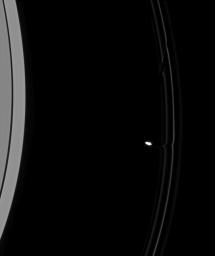
|
Opening a Channel
- Click the image above for a larger view
- Full-Res JPEG (746 x 887) (18.4 kB)
- Full-Res TIFF (746 x 887) (662.6 kB)
Caption:
As Prometheus pulls away from an encounter with Saturn's F ring, its immediate effects on the ring material are clear. The moon has pulled toward it a faint streamer of material from the inner, flanking ringlet and even created a modest bulge in the ring's bright core.
Above the moon in this image is the feature created during the previous passage of Prometheus (86 kilometers, or 53 miles across). The older streamer feature has sheared diagonally over the course of an orbit, becoming a dark channel. This too is the fate of the newly created streamer.
This view looks toward the sunlit side of the rings from about 14 degrees below the ringplane. The image was taken in visible light with the Cassini spacecraft narrow-angle camera on Aug. 6, 2008. The view was obtained at a distance of approximately 1 million kilometers (635,000 miles) from Prometheus and at a Sun-Prometheus-spacecraft, or phase, angle of 32 degrees. Image scale is 6 kilometers (4 miles) per pixel.
Background Info:
The Cassini-Huygens mission is a cooperative project of NASA, the European Space Agency and the Italian Space Agency. The Jet Propulsion Laboratory, a division of the California Institute of Technology in Pasadena, manages the mission for NASA's Science Mission Directorate, Washington, D.C. The Cassini orbiter and its two onboard cameras were designed, developed and assembled at JPL. The imaging operations center is based at the Space Science Institute in Boulder, Colo.
For more information about the Cassini-Huygens mission visit http://saturn.jpl.nasa.gov/ . The Cassini imaging team homepage is at http://ciclops.org .
Cataloging Keywords:
| Name | Value | Additional Values |
|---|---|---|
| Target | Prometheus | F Ring, Saturn Rings |
| System | Saturn | |
| Target Type | Satellite | Ring |
| Mission | Cassini-Huygens | |
| Instrument Host | Cassini Orbiter | |
| Host Type | Orbiter | |
| Instrument | Imaging Science Subsystem (ISS) | |
| Detector | Narrow Angle Camera | |
| Extra Keywords | Grayscale, Visual | |
| Acquisition Date | ||
| Release Date | 2008-09-03 | |
| Date in Caption | 2008-08-06 | |
| Image Credit | NASA/JPL/Space Science Institute | |
| Source | photojournal.jpl.nasa.gov/catalog/PIA10461 | |
| Identifier | PIA10461 | |
